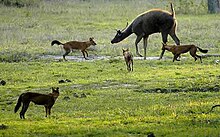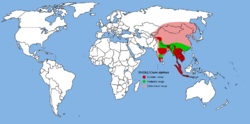Red dog
| Red dog | ||||||||||||
|---|---|---|---|---|---|---|---|---|---|---|---|---|

Red dog |
||||||||||||
| Systematics | ||||||||||||
|
||||||||||||
| Scientific name of the genus | ||||||||||||
| Cuon | ||||||||||||
| Hodgson , 1838 | ||||||||||||
| Scientific name of the species | ||||||||||||
| Cuon alpinus | ||||||||||||
| ( Pallas , 1811) |
The red dog ( Cuon alpinus ) or Asian wild dog is a wild dog widespread in Asia . Together with the wolf and the African wild dog, it is one of the large, pack- forming hunters among the dogs.
The red dog can be found in the literature under numerous names that can cause confusion. The name Asian red wolf can lead to confusion with the not closely related red wolf . The name alpine wolf is nonsensical due to the distribution area, but is used in the literature. In addition, the names Dhole (Indian name of the red dog, for example in Rudyard Kipling's jungle book) and Adjak (Javanese name) are used.
features
Asian wild dogs reach a head body length of almost 1 m, with a 45 cm tail. The height is 45 cm and their weight is 20 kg. The name "Rothund" comes from the color of the coat, which fluctuates between shades of reddish brown and orange. The underside is whitish. The tail is always darker than the body and black at the tip. It differs from most other dogs in that it has fewer molars in the lower jaw. The red dog has only 40 teeth instead of 42.
distribution and habitat
The red dog is distributed over various climatic zones from Altai and Manchuria south to India and Indonesia . In Borneo and Sri Lanka , where red dogs are not recently found, the genus Cuon still occurred in the Pleistocene . At that time it was also common in Europe and possibly even in North America.
As a rule, wolves and red dogs avoid each other, so that there are sharply separated areas of distribution between the two species. Unlike wolves, red dogs avoid open areas such as steppes and deserts. Mountain steppes are, however, populated. They live mainly in forests, both in the coniferous forests along the Amur and in the tropical rainforests of Southeast Asia and in the dry and monsoon forests of India. In the former Soviet Union, the red dog mainly lives in mountainous regions.
Way of life
In group behavior there are many parallels to wolves and African wild dogs. The pack size of the red dogs is between five and twelve, rarely over thirty individual animals. The pack is led by an alpha couple who are the only ones responsible for fathering offspring. The gestation period is sixty days; there are an average of six, sometimes up to nine, puppies in the litter. The whole pack helps raise the young.
The hunt is similar to that of the African wild dog, but the red dog does not reach such rapid speeds because of its shorter legs. The prey animals include deer , reindeer , roe deer , ibex , wild sheep and wild boar . Even animals as huge as Gaure are overwhelmed in packs. In India, the axis deer is its main prey. Rodents, carrion and insects are also eaten, and they are not averse to even vegetable foods in the form of berries. Usually three to four members of a pack take part in a hunt. Mostly the alpha male leads the hunt, it grabs the prey by the hind legs, the other pack members catch up and tear up the prey. Sometimes they start to eat the prey while it is still alive, there is no targeted killing bite .
Apart from humans, red dogs have few enemies. In packs, they can even overwhelm and kill bears and leopards. If enough dogs get together, they will be able to drive even a full-grown tiger off its crack. However, there has been no credible report of a red dog attack on humans. In Rudyard Kipling's book The Second Jungle Book there is a narrative in which Dhole a wolf pack attack. Here they are considered to be particularly bloodthirsty, but red dogs are also often decried as beasts. Red dogs are arguably no more bloodthirsty than other predators and only kill to survive. Yet this bad image earned them human hatred. He also chased the wild dogs as cattle robbers, and in some cases even shooting bonuses were paid.
Duration
The IUCN lists the red dog in the status "critically endangered". The number of wild red dogs is estimated to be less than 2500 animals. The main causes of the persistent decline in the population are the destruction of the habitat and the transmission of diseases through feral domestic dogs .
The species has almost disappeared from Siberia and Turkestan and Mongolia . There are no confirmed, more recent reports on red dogs from Kazakhstan , Kyrgyzstan , Russia , Tajikistan and Mongolia. The situation in the Chinese part of the Tianshan Mountains is unclear. Some are still in China, in the mountains of West Sichuan , South Gansu and East Qinghai . In Tibet, especially in the border area with Ladakh and in south-east Tibet, these wild dogs can still be found, and in Indochina and Myanmar there are also smaller populations, but mostly in isolated occurrences. Little is known about the situation on the Malay Peninsula as well as Java and Sumatra , but here they are probably limited to a few protected areas.
In India, at least in some national parks such as Periyar , Nagarhole and Kanha , they were able to survive to some extent. Especially in the central highlands of the Dekkan, the West and East Ghats, as well as in Northeast India (Arunachal Pradesh, Assam, Meghalaya and West Bengal) they still occur today.
Evolution and systematics
|
Phylogenetic position of the genus Cuon according to Koepfli et al. 2015
|
The red dog is the only representative of the monotypical genus Cuon . The first scientific description was made in 1811 by the natural scientist Peter Simon Pallas .
As part of the presentation of the genome sequence of the domestic dog , Lindblad-Toh et al. 2005 published a phylogenetic analysis of dogs (Canidae). In this presentation, the monophyly of the wolf and jackal species (genus Canis ) was questioned on the basis of molecular biological data . Accordingly, the striped jackal ( Canis adustus ) and the black-backed jackal ( Canis mesomelas ) represent sister species, which are compared as the most basic species to all other representatives of the genus as well as the red dog ( Cuon alpinus ) and the African wild dog ( Lycaon pictus ). These two species would have to be included in the Canis genus in order for it to survive as a monophyletic genus.

11 subspecies of the red dog can be distinguished on the basis of body size and fur. However, many descriptions are based only on a few individuals, and so it is not certain whether all subspecies are valid. The only one that clearly differs from the other subspecies is the Turkestan alpine wolf ( Cuon alpinus hesperius ). Other potential subspecies are:
- Cuon alpinus alpinus , alpine wolf; Eastern Russia, from the Lake Baikal region to and including the Amur and Ussuri region ; thick, yellow-brown-reddish fur with a greyish neck and ocher-colored muzzle.
- Cuon alpinus javanicus , Java red dog; Java and Panataia ; short light red fur.
- Cuon alpinus sumatrensis ; Sumatra; short, light red fur with dark whiskers.
- Cuon alpinus infuscus ; Southern Myanmar , Malaysia , Thailand , and Vietnam ; dark brown fur and peculiarities in the skull structure.
- Cuon alpinus adustus , Burmese red dog; Northern Myanmar and Indochina ; red-brown fur.
- Cuon alpinus dukhunensis , Dekkan red dog ; south of the Ganges in India; red fur and black whiskers, short hair between the pads.
- Cuon alpinus primaevus ; Himalayan region of Nepal , Sikkim , and Bhutan ; longer, redder fur than C. a. dukhunensis , long hair between the pads .
- Cuon alpinus hesperius , Turkestan alpine wolf; South Siberia , East Turkestan and Northwest China ( Altai and Tianshan ); long, light yellow fur with a white underside and pale whiskers.
- Cuon alpinus laniger ; Kashmir and Southern Tibet; completely yellow-gray fur.
- Cuon alpinus fumosus ; Western Sichuan , China, and Mongolia; lush, yellow-red fur with a dark back and gray neck.
- Cuon alpinus lepturus , Kiangsi alpine wolf; south of the Yangtze River in China; Uniform red fur with a dense undercoat.
According to Wilson & Reeder 2005, the nominate form Cuon alpinus alpinus as well as Cuon alpinus hesperius and Cuon alpinus sumatrensis are only three valid subspecies.
supporting documents
- ↑ Rudyard Kipling: The Second Jungle Book: Red Dog
- ↑ Klaus-Peter Koepfli, John Pollinger, Raquel Godinho, Jacqueline Robinson, Amanda Lea, Sarah Hendricks, Rena M. Schweizer, Olaf Thalmann, Pedro Silva, Zhenxin Fan, Andrey A. Yurchenko, Pavel Dobrynin, Alexey Makunin, James A. Cahill , Beth Shapiro, Francisco Álvares, José C. Brito, Eli Geffen, Jennifer A. Leonard, Kristofer M. Helgen, Warren E. Johnson, Stephen J. O'Brien, Blaire Van Valkenburgh, Robert K. Wayne: Genome-wide Evidence Reveals that African and Eurasian Golden Jackals Are Distinct Species. In: Current Biology. 2015, doi : 10.1016 / j.cub.2015.06.060 .
- ^ A b Don E. Wilson & DeeAnn M. Reeder (eds.): Cuon alpinus in Mammal Species of the World. A Taxonomic and Geographic Reference (3rd ed).
- ↑ Kerstin Lindblad-Toh et al .: Genome sequence, comparative analysis and haplotype structure of the domestic dog. Nature 438, December 2005; Page 803–819. ( Abstract ).
- Jump up ↑ Iyengar A., Babu VN, Hedges S., Venkataraman AB, Maclean N., Morin PA: Phylogeography, genetic structure, and diversity in the dhole (Cuon alpinus) . Molecular Ecology (2005) 14, 2281-2297
literature
- Ronald M. Nowak: Walker's Mammals of the World . 6th edition. Johns Hopkins University Press, Baltimore 1999, ISBN 0-8018-5789-9 (English).
Web links
- Dhole Cuon alpinus at IUCN SSC Canid Specialist Group
- The Asiatic Wild Dog or Dhole (Cuon alpinus) (1999/2004) ( Memento from November 12, 2014 in the Internet Archive ) (English), originally in: www.holgerhomann.us
- Cuon alpinus in the endangered Red List species the IUCN 2006. Posted by: Durbin et al , 2004. Retrieved on 9 May, 2006.



